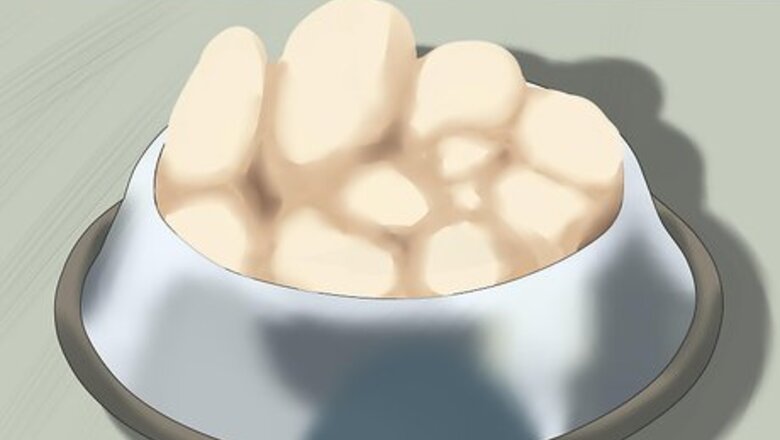
views
Treating Acid Reflux with Diet Control
Take your dog to the vet if they vomiting regularly or shows sign of discomfort. If your dog spits up its food, has a lack of appetite, or whines whenever it’s swallowing, it may have acid reflux. Schedule an appointment with a veterinarian to get an official diagnosis.

Feed your dog a low fat, low protein diet. Avoid high-fat, high-protein diets because these cause the stomach to produce acid. Instead offer carbohydrate such as rice, pasta, or boiled potatoes, with lean white meats such as chicken, turkey, cod, or coley fish. Examples of "bad" foods include fatty mince, sausages, bacon, cream, butter, and pate.

Feed your dog four small meals a day. If you feed your dog two or three large meals a day, there is more of a chance that his stomach will become very full, which in turn can stretch the esophageal sphincter and allow acid to leak out of the stomach. Continue feeding your dog four small low-fat, low protein meals a day until he has been symptom-free for at least 7 days. After these 7 days have passed, you can consider putting him back on his regular diet.
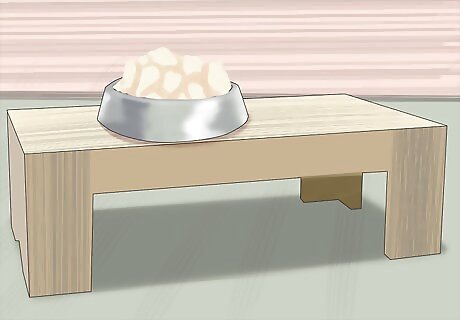
Place your dog’s food bowl on a stool or low table. Putting your dog’s food up high will force your dog to eat with his head raised above his shoulders. This makes his esophagus into a downhill slope to his stomach, which will help to keep the food in his stomach, rather than being regurgitated back up. Feeding from a raised bowl may give your dog bloat, a serious life-threatening condition that causes the stomach to twist and fill with gas.
Treating Acid Reflux with Gastroprotective Medications
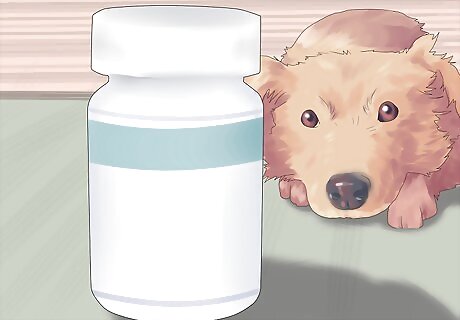
Give your dog gastroprotectants. Gastroprotectants provide a degree of protection for the stomach (and esophagus). The most widely used gastroprotective is sucralfate, a prescription medication known as Antepsin or Carafate.
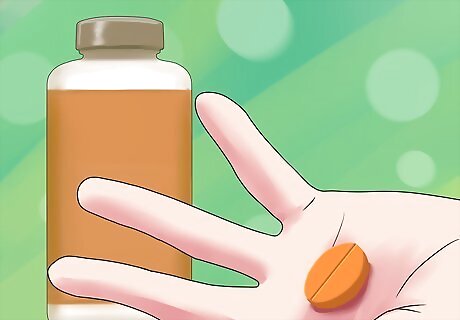
Give your dog omeprazole. This is also known as GastroGard or Prilosec. It is a prescription medication. It is a proton pump inhibitor and prevents acid production both in the stimulated stomach (when there is food to digest) or resting state (an empty tummy). The dose is 0.5 mg per 1 kg of weight once daily by mouth. Omeprazole comes in a range of tablet strengths (10mg, 20mg, 40mg) and so a 30-kg dog is best served with one 15-mg tablet once a day. Omeprazole is a very safe medication, with few reported side effects. There is a theoretical risk that if used for several months, the lack of acidity in the stomach could allow yeasts to overgrow, but this has not been proven.
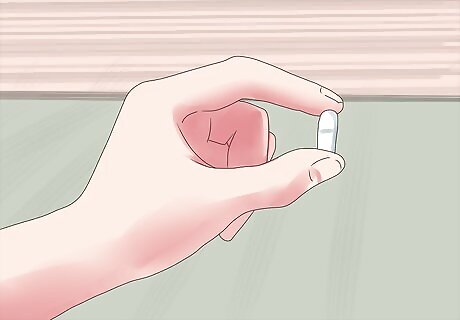
Get your dog a prescription for sucralfate. Sucralfate is widely used as an anti-ulcer drug in humans that can also be used in animals if prescribed correctly. Sucralfate turns into a paste-like substance when it comes into contact with acid. It then sticks to the inflamed tissue, which seals the raw area off from the acid. The dose is a ballpark figure of 0.5 to 1 gram by mouth three times a day (larger dogs receive around 1 gram, while smaller dogs will receive 0.5). The liquid form of this medication is more effective than the tablet for acid reflux because the liquid coats the esophagus as it trickles down the gullet. The dose for the liquid form of this medication is 2.5 to 5 ml by mouth three times daily. Sucralfate is so effective a barrier that it does stop other drugs from being absorbed. Because of this, if your dog is taking other medications, you should give them to your dog an hour before you give him the sucralfate.
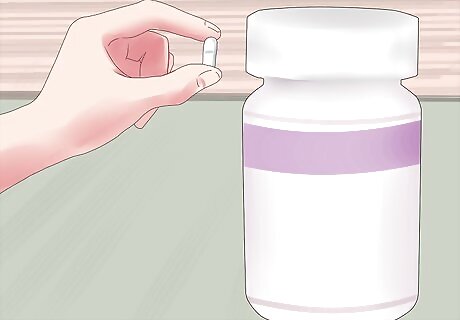
Try giving your dog a prokinetic medication. A prokinetic medication increases the muscular tone of the digestive tract. The importance of this is that it tightens up the esophageal sphincter and makes it less likely that stomach acid will be able to leak into your dog’s esophagus. There is one important prokinetic, metoclopramide.
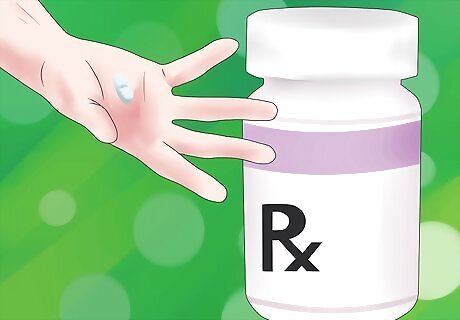
Get your dog a prescription for Metoclopramide. Metoclopramide works by helping the gastrointestinal tract deal with acetylcholine (a neurotransmitter that gives messages for muscles to contract). This helps to keep the esophageal sphincter closed so acid can’t get into the esophagus. The dose of metoclopramide is 0.1 to 0.4mg/ kg four times a day by mouth. A 30 kg dog requires 3 to12 mg a dose, so giving one 5 mg tablet four times a day is a sensible starting point. Metoclopramide should not be given to dogs with a bowel obstruction, because the enhanced muscular contraction could cause bowel perforation. Also, metoclopramide is thought to increase prolactin release (the hormone that stimulates milk production) and should be avoided in female dogs have a false pregnancy as it will aggravate the symptoms. False pregnancy is where hormones fool the bitch into thinking she is pregnant when she isn't. Part of this is to prepare her to feed the "phantom" puppies by producing milk. However, lactating when there are no puppies to suckle the milk can make the bitch more likely to develop infections of the mammary gland, such as mastitis.
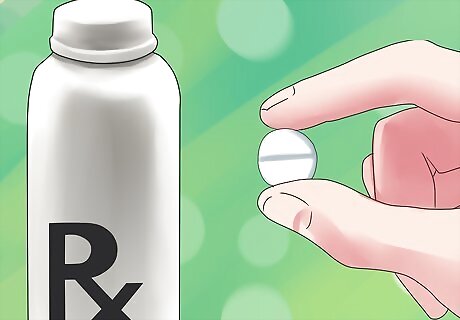
See if antacid medications help your dog. Antacids decrease the amount of acid produced by the stomach, so they limit the amount of acid that could leak up into your dog’s esophagus. Some over the counter antacids are available (such as famotidine, marketed as Pepcid), while stronger antacids are prescription only (omeprazole).
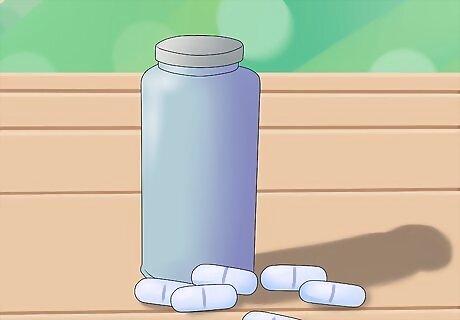
Buy famotidine for your dog. Famotidine is an H2-receptor antagonist which means it slows down the production and secretion of acid in your dog’s stomach. Famotidine is available over-the-counter at pharmacies. There is no veterinary equivalent and so it is acceptable to purchase famotidine yourself in order to medicate your dog. The recommended dose range is quite wide, but an average dose is around 0.5mg/kg by mouth twice a day. Thus a 30 kg dog would be given one-and-a-half 10 mg tablets twice a day. Give this medication on an empty stomach. Famotidine can be given long-term without reported incident.
Spotting and Diagnosing Acid Reflux
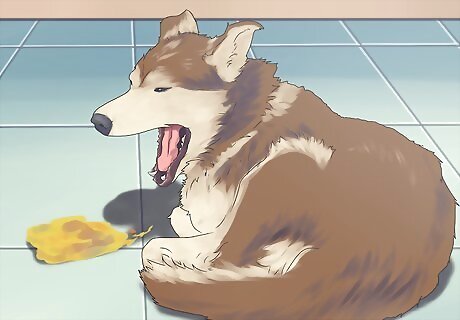
Look for signs that your dog has acid reflux. If your dog has reflux, he may begin showing some of the following symptoms: Spitting up food. Pain shortly after swallowing (your dog may whine when he tries to swallow). Weight loss and a lack of appetite.
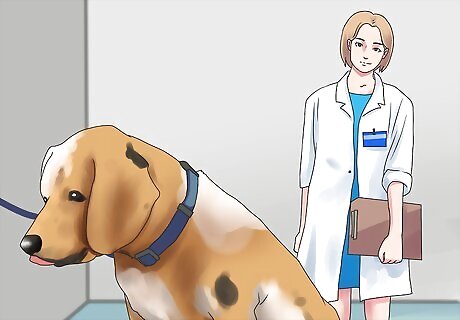
Bring your dog to a vet to be diagnosed. The vet will use an endoscopy to determine if your dog has acid reflux or not. An endoscopy involves sending a small camera down your dog’s throat to inspect the lining of the esophagus. A dog with acid reflux will have a red, raw, sore, ulcerated looking esophagus near the opening to the stomach.
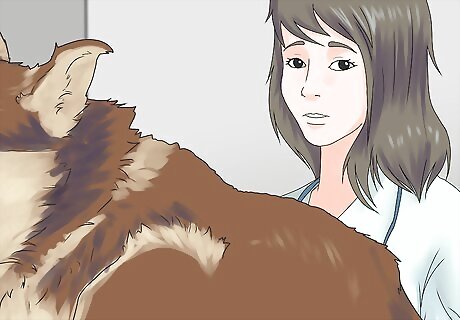
Work with your vet to come up with a treatment plan. While this article outlines the steps you can take to help your dog, it is important to work with your vet to make sure that your dog gets the appropriate treatment given his specific medical history.



















Comments
0 comment